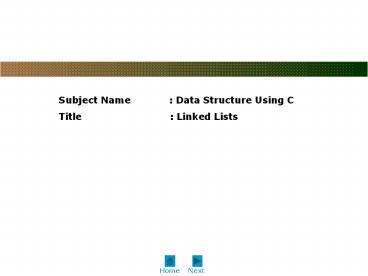Next - PowerPoint PPT Presentation
1 / 16
Title:
Next
Description:
Next Home Singly Linked List Doubly Linked List Circular Linked List Type of Linked Lists Next ... Node Tail Node Deletion of a Node from Doubly Link List : ... – PowerPoint PPT presentation
Number of Views:114
Avg rating:3.0/5.0
Title: Next
1
Subject Name Data Structure Using C Title
Linked Lists
Next
Home
2
Linked Lists
- It consists of a sequence of nodes, each
containing arbitrary data fields and one or two
references ("links") pointing to the next and/or
previous nodes. A linked list is a
self-referential data type because it contains a
pointer or link to another datum of the same
type. Linked lists permit insertion and removal
of nodes at any point in the list in constant
time, but do not allow random access. - The principal benefit of a linked list over a
conventional array is that the order of the
linked items may be different from the order that
the data items are stored in memory or on disk,
allowing the list of items to be traversed in a
different order. - Several different types of linked list exist
Singly Linked List, Doubly Linked List, and
Circular Linked List.
Next
Home
3
- Hierarchical Structure of Linear List
Next
Home
4
- There are basic FOUR operations performed on
linear lists - Insertion of Nodes an insertion can be made at
the any of the lists - Deletion of Nodes Deletion from general list
requires that the list be searched for the data
to be deleted. - Retrieval of Values List retrieval requires
that data be located in a list and presented to
the calling module without changing the contents
of the lists. - Traversal in the List List traversal is a
special case of retrieval in which all the
elements are retrieved in a sequence.
Next
Home
5
Type of Linked Lists
- Singly Linked List
- Doubly Linked List
- Circular Linked List
Next
Home
6
- Singly Linked List
Arbitrary Address of the Node
100
300
400
200
700
Tail Node
Head Node
Address Part
Data Part
Next
Home
7
- Insertion of a Node in Singular Link List
Insert node value 45 after node value 9
100
300
700
400
200
(1)
600
Head Node
Tail Node
Insertable Node
100
300
700
400
200
(2)
600
Head Node
Tail Node
Inserted Node
Next
Home
8
- Deletion of a Node in Singular Link List Delete
node value 12
100
300
700
400
200
(1)
Head Node
Tail Node
100
300
700
400
200
(2)
Head Node
Tail Node
Next
Home
9
- Doubly Linked List
Data Part
100
300
600
200
Tail Node
Head Node
Address Part
Next
Home
10
- Insertion of a Node in Doubly Link List Insert
node value 45 after node value 7
100
300
600
200
(1)
700
Head Node
Tail Node
Insertable Node
100
300
600
200
(2)
700
Head Node
Tail Node
Inserted Node
Next
Home
11
- Deletion of a Node from Doubly Link List
Delete node value 86
100
300
600
200
(1)
Head Node
Tail Node
100
300
600
200
(2)
Head Node
Tail Node
Next
Home
12
- Circular Linked List
100
300
400
200
700
Tail Node
Head Node
Next
Home
13
- Insertion of a Node in Circular Link List
Insert node value 44 after node value 12
100
300
700
400
200
(1)
500
Tail Node
100
300
700
400
200
(2)
500
Tail Node
Next
Home
14
- Deletion of a Node from Circular Link List
Delete the node value 5
100
300
400
200
700
Tail Node
100
300
700
400
200
Tail Node
Next
Home
15
Application of Linked List
- Large Numeric Arithmetic
- Optimum Utilization of Memory Space
- Represent Complex Structure Tree, Graph
Next
Home
16
(No Transcript)

